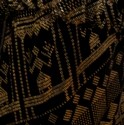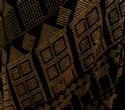dress
| Nom de l'objet : | dress |
| Catégorie de l'objet : | Personal Artifacts |
| Sous-catégorie de l'objet : | Clothing - outerwear |
| Discipline : | social history |
| Matériaux : | fibre, synthetic metal fibre fibre, satin |
| Numéro d'accession : | 989.1.9 |
| Province d'utilisation : | New Brunswick |
| Pays d'utilisation : | Canada |
| Culture : | European French |
| Date de début de production : | 1920 c |
| Date de fin de production : | 1930 c |
| Description : | This black evening dress, lined in black satin, is a flapper-style garment from the early 1920s. This dress clearly portrays an exotic influence. There are three distinct repeating patterns which appear in diagonal lines on the dress: houses, figures with raised arms holding palms, and large single palm leaves. |
| Commentaires : | During the 1920s a style of dress emerged from the haute couture fashion houses of Paris. This was the decade of the flappers (as they were known in the US, also known as Bright Young Things in Britain). Following the deaths of so many young men during the First World War, women began to take on a more boyish style that was referred to as "garconne". Dress styles during this time focused less on the female body. This evening dress reveals some popular characteristics of this era. Some features include the sleeveless design, which gave the impression of carefree youthfulness; the low hip line would have been flattened with the use of a corselet to reduce natural curves giving the clothed figure a basically "tubular" look from the shoulders straight down to the hem. The neckline of this dress bears resemblance to the sleeveless jumper dress with the draped panel drawing the eye away from the flattened bosom to the midsection. Another characteristic of this era was the influence of primitivism on the pattern adorning only the most fashionable clothing. With the recent discovery of the tomb of King Tutankhamen in Egypt, a new international view of the world brought pattern influences from South America's pre-Columbian tapestries, Eastern European folk embroidery, and the popular triangle motif of the West African cloths. This dress clearly portrays an exotic influence. There are three distinct repeating patterns which appear in diagonal lines on the dress: houses, figures with raised arms holding palms, and large single palm leaves. |
| Fonctions : | May have been worn by Ethel Todd, wife of Lieutenant Governor Todd. |
| Unité de mesure linéaire : | cm |
| Établissement : |
Charlotte County Museum
 Facebook-Charlotte County Museum Facebook-Charlotte County Museum
|
| Ville de l'établissement : | St. Stephen |
| Province de l'établissement : | New Brunswick |
Coordonnées de cette page web
-
Pour proposer des corrections ou des mises à jour sur cette page, veuillez contacter directement le Réseau canadien d’information sur le patrimoine (RCIP).




